Blackbirds in North Carolina 8 Types of Blackbirds
Blackbirds are incredibly abundant in North Carolina. But while they are common, some of these species get a bad reputation because of their aggressive personalities and tendency to “bully” smaller songbirds at bird feeders (cough… European Starlings… cough).
The term “blackbird” is a bit wide-ranging. For the sake of this article, I only included species in the Icteridae family (except for #2), which consists of all New World Blackbirds, grackles, cowbirds, and even orioles! I think you will find that the more you learn about the below birds, the more you can appreciate them and their natural behavior.
1. Red-winged Blackbird
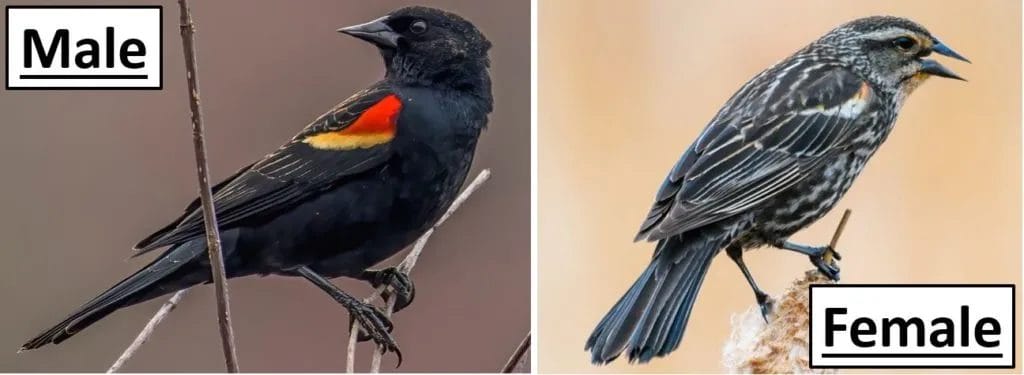
Identifying Characteristics:
- Males are all black, except for a bright red and yellow patch on their shoulders.
- Females are brown and heavily streaked. There is a bit of yellow around their bill.
- Both sexes have a conical bill and are commonly seen sitting on cattails or perched high in a tree overlooking their territory.
During the breeding season, these blackbirds are almost exclusively found in marshes and other wet areas. Females build nests in between dense grass-like vegetation, such as cattails, sedges, and bulrushes. Males aggressively defend the nest against intruders, and I have even been attacked by Red-winged Blackbirds while walking near the swamp in my backyard!
When it’s the nonbreeding season, Red-winged Blackbirds spend much of their time in grasslands, farm fields, and pastures looking for weedy seeds to eat. It’s common for them to be found in large flocks that feature various other blackbird species, such as grackles, cowbirds, and starlings.
2. European Starling
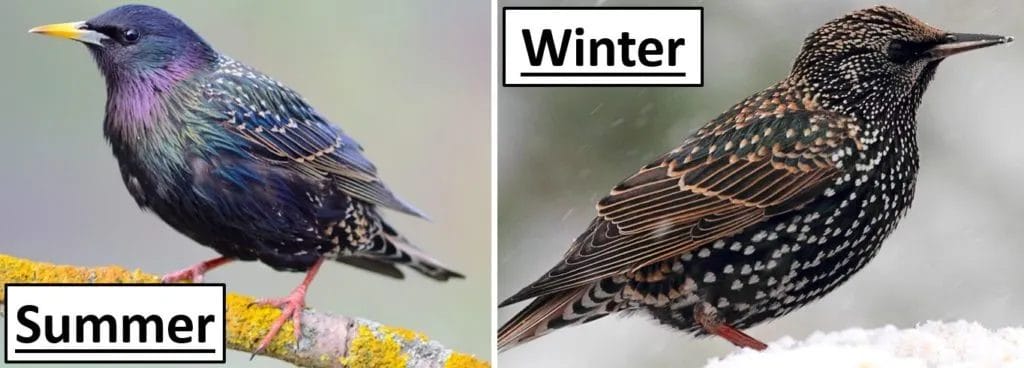
Identifying Characteristics:
- A common blackbird in North Carolina, they are about the size of an American Robin. Their plumage is black and appears to be shiny.
- Short tail with a long slender beak.
- Breeding adults are darker black and have a green-purple tint. In winter, starlings lose their glossiness, their beaks become darker, and they develop white spots over their bodies.
- Back in 1890, one hundred starlings were brought over from Europe and released in New York City’s Central Park. The man responsible (Eugene Schieffelin) had a mission to introduce all of the birds mentioned in Shakespeare’s plays in North America.
- The rest is history as starlings easily conquered the continent, along the way out-competing many of our beautiful native birds. Their ability to adapt to human development and eat almost anything is uncanny to almost no other species.
3. Brown-headed Cowbird
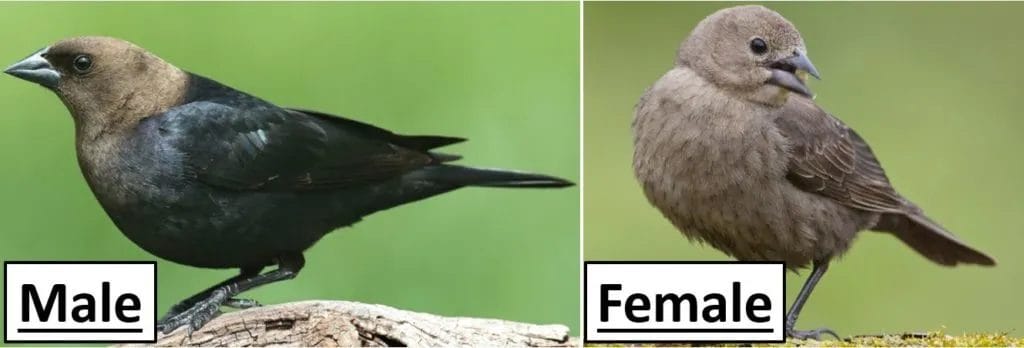
Identifying Characteristics:
- Look for a stocky, chunky blackbird with a thick, conical bill.
- Males have completely black bodies with brown heads (hence the name). In poor light, it can be hard to tell that the head is brown.
- Females are a plain brown color. There is slight streaking on the belly and a black eye.
In North Carolina, these blackbirds are naturally found in grasslands, brushy thickets, prairies, and woodland edges. But they have greatly expanded their range due to human development, and they have adapted well to residential areas, pastures, orchards, and cemeteries.
Cowbirds have a truly interesting way of reproducing. Instead of spending energy building nests and raising their young, they let other birds do it for them! Females deposit their eggs INSIDE the nests of other species, which means the “chosen” bird does all the hard work.
4. Common Grackle
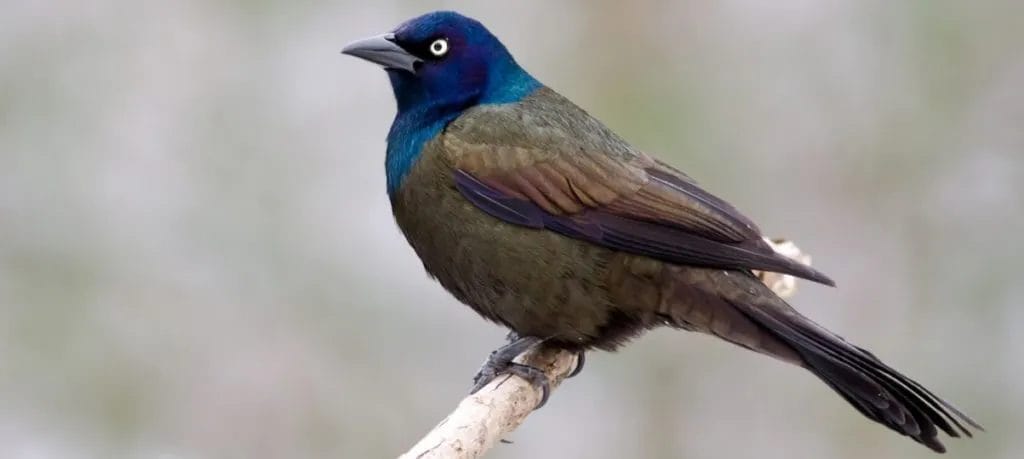
Identifying Characteristics:
- Lanky, large blackbirds that have a long tail and long bill that curves slightly downward. Loud birds gather in big flocks high in trees.
- Males are black overall but have an iridescent blue head and bronze body when seen in the right light.
- Females look similar, except they are slightly less glossy than males.
- Common Grackles are one of the most resourceful blackbirds you will find in North Carolina.
- Their favorite foods are grains, such as corn and rice, and they are known to gather in enormous flocks in farm fields growing these crops. In addition, they also eat a wide variety of seeds, acorns, fruits, insects, spiders, frogs, fish, mice, other birds, and even garbage!
5. Baltimore Oriole]
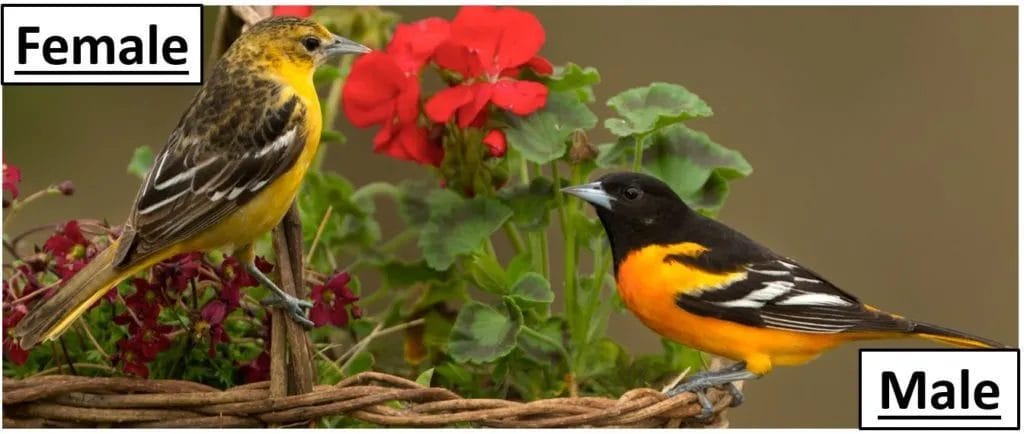
Identifying Characteristics:
- Male birds are a stunning combination of orange and black with white wing bars.
- Females are beautiful in their way, featuring duller colors than the males while lacking a black hood and back.
When you think about blackbirds in North Carolina, you probably don’t think about Baltimore Orioles! But it’s true, as these stunning birds are members of the Icteridae family.
These blackbirds spend most of their time at the tops of deciduous trees, fluttering around, building beautiful woven nests, and looking for food.
They are most often found in open woodlands, riverbanks, and on the edges of swamps and forests. Even though they enjoy trees, they normally aren’t seen in deep, dark forests.
6. Orchard Oriole
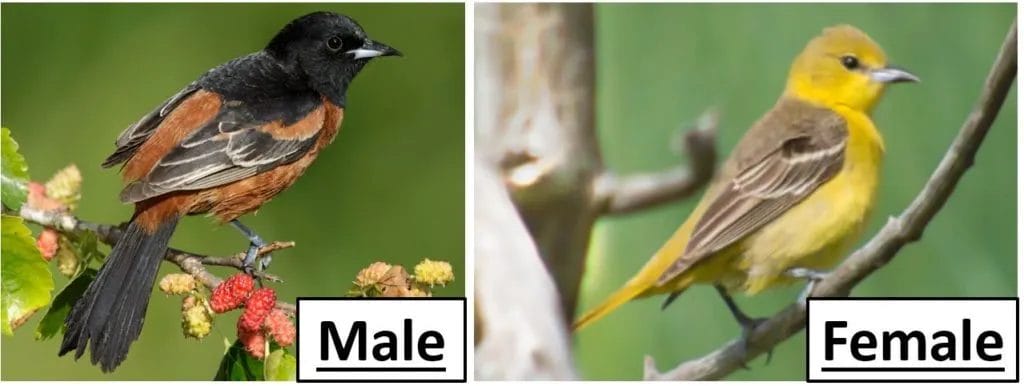
Identifying Characteristics:
- Male Orchard Orioles are a darker orange than Baltimore Orioles. Their plumage is best described as rust-colored.
- Females are greenish-yellow, with white wing bars on black wings.
But these shy birds are not often seen because they spend most of their time at the tops of trees. Preferred habitat includes the edges of rivers, swamps, lakeshores, open woodlands, farms, and scrublands. In winter, they migrate south to Central and South America.
While many oriole species regularly visit bird feeders, Orchard Orioles are much harder to attract to them.
You are probably more likely to see these blackbirds in your backyard searching for insects in shrubby vegetation or eating mulberries from a tree. But if you’re lucky, you may see them at your feeders eating sunflower seeds or orange slices, drinking sugar water from a nectar feeder, or sipping a bit of grape jelly.
7. Rusty Blackbird
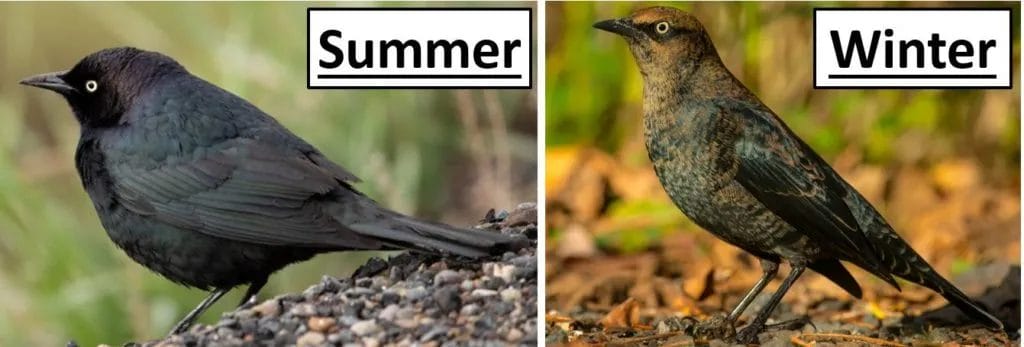
Identifying Characteristics:
- Medium-sized blackbirds with slightly curved, slender bills.
- Breeding males are entirely glossy black. Non-breeding males are a duller black but with rusty-brown edging on their plumage.
- Females appear rusty colored or brown. Look for a pale eyebrow that contrasts against the black feathers around their eye.
- The problem with studying these blackbirds is that they breed in Canada’s far northern boreal forests, where not many people are around to observe their behavior.
- Their preferred habitats are wet forests, marshes, pond edges, and swamps. Many of these areas have been drained and converted to agricultural uses, which may play a part in the loss of Rusty Blackbirds.
- It’s also thought that the severe hunting of beavers over the past century has eliminated many smaller ponds, which is also another natural home used by these blackbirds.
8. Boat-tailed Grackle
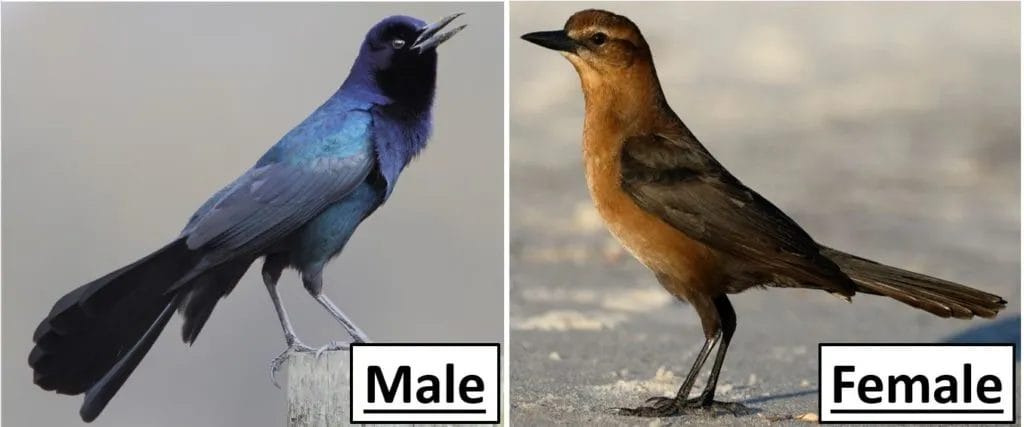
Identifying Characteristics:
- These grackles are lanky looking and have long legs with a large, pointed bill.
- As the name suggests, adults have a long, V-shaped tail, which resembles the keel of a boat.
- Males are glossy black all over. Females look completely different, as they are smaller with a pale brown breast and dark brown upper parts.
When they are in the vicinity, it’s easy to identify and see these loud blackbirds in North Carolina! Naturally, look for them in coastal salt marshes. But the easiest place to see them is around people as Boat-tailed Grackles are not shy!
They readily take advantage of humans for food and protection from predators. For example, when our family visits Disney World, I see them in large numbers, hanging out around busy food areas looking to scavenge leftover popcorn, pretzels, and french fries.
Boat-tailed Grackles have a unique mating system called “harem defense polygamy,” which is similar to how deer and elk breed. Female birds all cluster their nests close together and then let males compete (through displays and fighting) to see who gets to mate with the entire colony.
Read More Article: Prehistoric Birds-Top 10 Prehistoric Birds
Read More Article: BIRDS Chirping AT NIGHT-Explained Completely
Read More Article: Water Birds- Here Are Few Types Of Water Birds
Read More Article: Indiana Birds-Top 15 Indiana Birds
Read More Article: Top 15 Most Beautiful Crested Birds
Read More Article: Can Dogs Eat Watermelon?